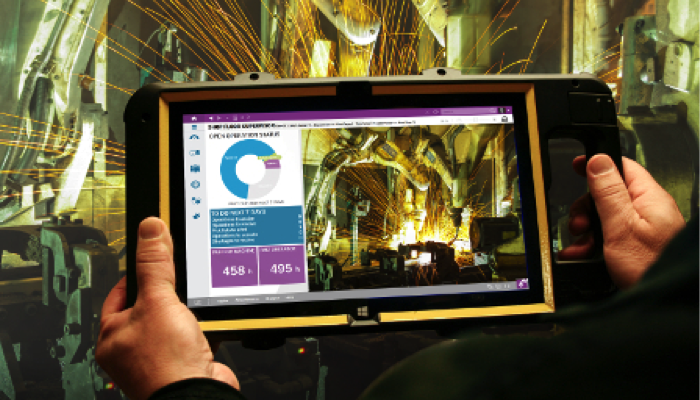Why Augmented Reality is the Future of the Field Service Industry...
Feb 13, 2018 • Features • Augmented Reality • Future of FIeld Service • Michael Blumberg • Oil and Gas • Bombardier • Bosch Rexroth • BYOD • Siemens Industrial Turbomachinery • utilities
Michael Blumberg, President Blumberg Advisory Group explains why Augmented Reality will be at the core of field service in the not too distant future giving examples of three companies that have already embraced this game-changing tech...
Want to know more? You’ll find a white paper on this topic @ fs-ne.ws/7Q9230fLKu7
If your Field Service Organization (FSO) is not using some form of remote telepresence or video collaboration tool today like Augmented Reality (AR) or Virtual Reality (VR), chances are you will be in the future.
There are many compelling data points and trends that support this prognosis. First, a recent study by Salesforce.com reports that 92% of service executives indicated they need to transform their service models to keep up with consumer needs.
Second, according to Aberdeen Group, Best in Class field service organizations are 72% more likely than their peers to utilize visual collaboration tools (e.g., AR/VR). It is only a matter of time before other companies follow suit. Third, end-customers have begun to expect this type of service experience. Indeed, 84% of millennial customers have used a self-service portal for customer service. The immersive nature of AR/VR apps makes it the ultimate self-service experience.
Customer demand is obviously a critical factor driving the proliferation of AR/VR applications in the field service industry.
Fueling the demand for AR/VR technology is the fact that it is both relevant and effective within a broad array of industry segments and use casesAs a result, the use of collaboration tools like AR will become the standard by which customers evaluate and measure field service performance. Fueling the demand for AR/VR technology is the fact that it is both relevant and effective within a broad array of industry segments and use cases.
Indeed, it is difficult to find any technology segments where AR/VR does not have practical value. In fact, any technology that is comprised of electronic, electro-mechanical (e.g., pneumatic, hydraulic, etc.) or electrical components can benefit from AR/VR enabled service and support.
Another factor driving demand is the fact that early adopters are achieving measurable results from the deployment of AR/VR pilot projects. For example:
Siemens Industrial Turbomachinery is exploring AR and VR solutions to increase both field service utilisation and productivity while reducing travel expenditures. AR would enable the company to send technicians who communicate with remote experts, thus reducing the total number of man-hours on site as well as travel costs.
Bombardier, a provider of propulsion and control equipment for trains, was able to make significant savings, per service event every time they utilized AR to resolve technical issues remotely.
Bosch Rexroth, a manufacturer of hydraulic drive systems, spent every year in Sweden alone a lot of travelling time to go to customer’s sites to inspect what problem or question the customer had prior to deploying AR. The company now offers its customers the option of purchasing support hours to their value-added service offering that utilizes AR to deliver remote support. The collaborative and visual aspects of this technology are far more effective than telephone support. As a result, Bosch Rexroth is now able to provide quicker uptime to customers while generating a profitable income stream.
The technology industry, of which field service is a subset, is already considered to be the biggest economic driver of ARIn the coming years, we are likely to see an exponential growth of AR in the field service industry. In fact, the technology industry, of which field service is a subset, is already considered to be the biggest economic driver of AR. Furthermore, industry forecasters anticipate that expenditures on AR technology will exceed $100 million by 2020.
While we are likely to see new developments in AR/VR feature functionality, this technology will be deployed in one of two environments:
- In support of an existing installed base of equipment
- Embedded in the design of new products
We are also likely to find different versions of AR deployed in the field. For example, certain service environments, like Oil & Gas or Utilities, may require that AR applications be integrated with rugged wearable devices to deliver a hands-free environment, whereas non-rugged wearable devices or smartphones/tablets may be more than sufficient in enabling a collaborative experience in markets like IT or Telecom.
As technology improves it is very likely that consumers will purchase AR for business use in much the same way they purchase their own laptops and smartphones for similar business use. It is also quite possible that “Bring Your Own Device” (BYOD) will apply to AR as well.
This will completely change the paradigm of service support and break down barriers to finding and hiring talent, which in turn will continue to facilitate the use of freelance technicians. Regardless of future possibilities, these potential developments should not stop FSOs from investing in AR and reaping the benefits today.
Be social and share





















 Field Service News is published by 1927 Media Ltd, an independent publisher whose sole focus is on the field service sector. As such our entire resources are focused on helping drive the field service sector forwards and aiming to best serve our industry through honest, incisive and innovative media coverage of the global field service sector.
Field Service News is published by 1927 Media Ltd, an independent publisher whose sole focus is on the field service sector. As such our entire resources are focused on helping drive the field service sector forwards and aiming to best serve our industry through honest, incisive and innovative media coverage of the global field service sector.
Leave a Reply